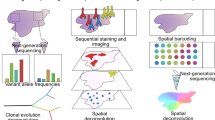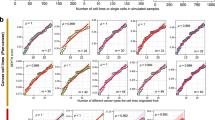Abstract
The extent of tumor heterogeneity is an emerging theme that researchers are only beginning to understand. How genetic and epigenetic heterogeneity affects tumor evolution and clinical progression is unknown. The precise nature of the environmental factors that influence this heterogeneity is also yet to be characterized. Nature Medicine, Nature Biotechnology and the Volkswagen Foundation organized a meeting focused on identifying the obstacles that need to be overcome to advance translational research in and tumor heterogeneity. Once these key questions were established, the attendees devised potential solutions. Their ideas are presented here.
This is a preview of subscription content, access via your institution
Access options
Subscribe to this journal
Receive 12 print issues and online access
$209.00 per year
only $17.42 per issue
Buy this article
- Purchase on Springer Link
- Instant access to full article PDF
Prices may be subject to local taxes which are calculated during checkout



Similar content being viewed by others
References
Zardavas, D. et al. Clinical management of breast cancer heterogeneity. Nat. Rev. Clin. Oncol. 12, 381–394 (2015).
Marusyk, A. et al. Intra-tumour heterogeneity: a looking glass for cancer? Nat. Rev. Cancer 12, 323–334 (2012).
McGranahan, N. & Charles Swanton, C. Biological and therapeutic impact of intratumor heterogeneity in cancer evolution. Cancer Cell 27, 15–26 (2015).
Chen, J.C. et al. Identification of causal genetic drivers of human disease through systems-level analysis of regulatory networks. Cell 159, 402–414 (2014).
Gould, S.E., Junttila, M.R. & de Sauvage, F.J. Translational value of mouse models in oncology drug development. Nat. Med. 21, 431–439 (2015).
Li, S. et al. Dynamic evolution of clonal epialleles revealed by methclone. Genome Biol. 15, 472 (2014).
de Biasi, A.R., Villena-Vargas, J. & Adusumilli, P.S. Cisplatin-induced antitumor immunomodulation: a review of preclinical and clinical evidence. Clin. Cancer Res. 20, 5384–5391 (2014).
Postow, M.A. et al. Immunologic correlates of the abscopal effect in a patient with melanoma. N. Engl. J. Med. 366, 925–931 (2012).
Twyman-Saint Victor, C. et al. Radiation and dual checkpoint blockade activate non-redundant immune mechanisms in cancer. Nature 520, 373–377 (2015).
Zamarin, D. et al. Localized oncolytic virotherapy overcomes systemic tumor resistance to immune checkpoint blockade immunotherapy. Sci. Transl. Med. 6, 26ra32 (2014).
Andtbacka, R.H.I. et al. Talimogene laherparepvec improves durable response rate in patients with advanced melanoma. J. Clin. Oncol. doi:10.1200/JCO.2014.58.3377 (26 May 2015).
Eggermont, A.M. et al. Cancer Core Europe: a consortium to address the cancer care-cancer research continuum challenge. Eur. J. Cancer 50, 2745–2746 (2014).
Bansal, M. et al. A community computational challenge to predict the activity of pairs of compounds. Nat. Biotechnol. 32, 1213–1222 (2014).
Siravegna, G. et al. Clonal evolution and resistance to EGFR blockade in the blood of colorectal cancer patients. Nat. Med. doi:10.1038/nm.3870 (1 June 2015).
Thress, K.S. et al. Acquired EGFR C797S mutation mediates resistance to AZD9291 in non–small cell lung cancer harboring EGFR T790M. Nat. Med. 21, 560–562 (2015).
Newman, A.M. et al. An ultrasensitive method for quantitating circulating tumor DNA with broad patient coverage. Nat. Med. 20, 548–554 (2014).
Dawson, S.J. et al. Analysis of circulating tumor DNA to monitor metastatic breast cancer. N. Engl. J. Med. 368, 1199–1209 (2013).
Rodrigues, T.B. et al. Magnetic resonance imaging of tumor glycolysis using hyperpolarized 13C-labeled glucose. Nat. Med. 20, 93–97 (2014).
Newman, A.M. et al. Robust enumeration of cell subsets from tissue expression profiles. Nat. Methods 12, 453–457 (2015).
Gentles, A.J. et al. The prognostic landscape of genes and infiltrating immune cells across human cancers. Nat. Med. 21, 940–947 (2015).
Pan, X. et al. Proc. Natl. Acad. Sci. USA 110, 594–599 (2013).
Macosko, E.Z. et al. Highly parallel genome-wide expression profiling of individual cells using nanoliter droplets. Cell 161, 1202–1214 (2015).
Klein, A.M. et al. Droplet barcoding for single-cell transcriptomics applied to embryonic stem cells. Cell 161, 1187–1201 (2015).
Fan, H.C., Fu, G.K. & Fodor, S.P. Expression profiling. Combinatorial labeling of single cells for gene expression cytometry. Science 347, 910–914 (2015).
Murphy, P.J. et al. Single-molecule analysis of combinatorial epigenomic states in normal and tumor cells. Proc. Natl. Acad. Sci. USA 110, 7772–7777 (2013).
Li, S. et al. The pivotal regulatory landscape of RNA modifications. Annu. Rev. Genomics. Hum. Genet. 15, 127–150 (2014).
Dey, S.S. et al. Integrated genome and transcriptome sequencing of the same cell. Nat. Biotechnol. 33, 285–289 (2015).
Seligson, D.B. et al. Global histone modification patterns predict risk of prostate cancer recurrence. Nature 435, 1262–1266 (2005).
Gomez, D. et al. Detection of histone modifications at specific gene loci in single cells in histological sections. Nat. Methods 10, 171–177 (2013).
Giesen, C. et al. Highly multiplexed imaging of tumor tissues with subcellular resolution by mass cytometry. Nat. Methods 11, 417–422 (2014).
Angelo, M. et al. Multiplexed ion beam imaging of human breast tumors. Nat. Med. 20, 436–442 (2014).
Lee, J.H. et al. Fluorescent in situ sequencing (FISSEQ) of RNA for gene expression profiling in intact cells and tissues. Nat. Protoc. 10, 442–458 (2015).
Chen, K.H., Boettiger, A.N., Moffitt, J.R., Wang, S. & Zhuang, X. Spatially resolved, highly multiplexed RNA profiling in single cells. Science 348, 6233 (2015).
Lee, J.H. et al. Highly multiplexed subcellular RNA sequencing in situ. Science 343, 1360–1363 (2014).
O'Connor, J.P. et al. Imaging intratumor heterogeneity: role in therapy response, resistance, and clinical outcome. Clin. Cancer Res. 21, 249–257 (2015).
Haeno, H. et al. Computational modeling of pancreatic cancer reveals kinetics of metastasis suggesting optimum treatment strategies. Cell 148, 362–375 (2012).
Acknowledgements
We would like to thank O. Grewe, M. Ruessman and S. Kim for their help in the organization of the meeting.
Author information
Authors and Affiliations
Corresponding author
Ethics declarations
Competing interests
A.A.A. is a cofounder of CAPP-Medical and a consultant for Roche, Genentech, CAPP-Medical and Celgene. K.P. has a sponsored research agreement and consultancy with Novartis Oncology.
Rights and permissions
About this article
Cite this article
Alizadeh, A., Aranda, V., Bardelli, A. et al. Toward understanding and exploiting tumor heterogeneity. Nat Med 21, 846–853 (2015). https://doi.org/10.1038/nm.3915
Received:
Accepted:
Published:
Issue Date:
DOI: https://doi.org/10.1038/nm.3915



